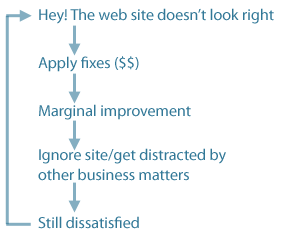Blog
When web sites fail: Don't throw good money after bad
We see it constantly. A new client calls us to update their existing web site, or one in progress—"We've got a guy working on it." Usually, elements of the site are broken, incomplete or need updating. We visit the site to find a hodgepodge of styles and colors, errors in coding, broken menus, missing videos or other items out of place.
How did we get here? Reasons include:
- There was no firm plan for the project.
- There was no plan for maintenance of site software and content.
- The budget was insufficient, so corners were cut.
- The original designer/developer left the project.
- Someone with limited technical skills worked on the site and made mistakes.
- The site uses outdated technology or elements that don't work on all devices.
- Or, the site simply hasn't been maintained for a long time.
For most clients, the instinct is to hire someone to clean up the mess. Sometimes, this is the right approach. If a web site is structurally sound, looks and works well, and just needs a little TLC, it's often worth spending money to fix it. However, in many cases, the best approach is to start over.
"What? No. We spent $X,XXX on this just three years ago. We don't want to spend a bunch more to make a brand new site!"
This is completely understandable. No one likes to feel like they've wasted money. However, web sites have a lifecycle—they don't last forever. In the case of a web site that was never great to begin with or is increasingly hard to maintain, starting over is often the best approach. Consider this cycle:

This is referred to as "throwing good money after bad"—continuing to spend money on a project that should be scrapped and replaced.
Perhaps most important, the site still isn't getting solid search engine rankings and site traffic is at a standstill—defeating the reason for having a website in the first place.
There's No Fountain of Youth for Websites
As noted earlier, web sites have a lifecycle—they don't last forever. Your web presence must contend with a host of changing factors, such as:
- Stale visuals. You don't need to be a fashionista to notice passé clothing or hair styles. Or is the sales manager who left the company two years ago still beaming in the employee lineup?
- Outdated platforms. Old platforms, particularly legacy platforms that use tangled, aging technology, are a real challenge to update. Frankly, it's not worthwhile. Switching to a modern framework will yield a website that functions well on customers' modern computers and can be more easily expanded and updated.
- Browsers, dead and alive. Sites built for outdated web browsers are missing key features that would make your customers' web experience easier and faster.
- Barfs on mobile devices peers. Yes, "barfs." A modern web site must be accessible across devices: desktops, laptops, tables and smartphones. If your site wasn't explicitly design with this in mind, it probably doesn't work properly on mobile devices.
Rapidly evolving technologies, changes in the ways people use the internet and your own marketing challenges can make the option of updating an existing website more costly—even in the not-so-long run.
Thinking about a fresh start? Contact Versa Studio today.
